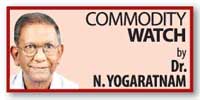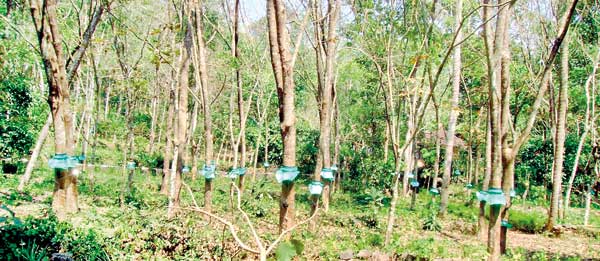Reply To:
Name - Reply Comment
 By Dr. N.Yogaratnam
By Dr. N.Yogaratnam
There had been a steady growth in the development of voluntary national eco-labelling and private CSR strategies. Over the course of the past decade, these approaches have been complemented by growth in the use of global and sector-wide voluntary standards and sustainability initiatives (VSIs), such as Fair Trade, Forest Stewardship Council, Rainforest Alliance, Round table on Sustainable Palm Oil etc.
Case for Natural Rubber (NR)
• The NR sector represents a renewable resource of significant importance to global economic growth.
• As a renewable resource, the NR sector is well placed to play an important role in lowering the environmental impact of vehicle-based transport and contributing to sustainable agricultural development.
• In order to take advantage of these opportunities, NR producing and consuming countries need to develop a globally credible and accepted framework for defining and implementing sustainable NR production.
• The international community, led by the relevant UN agencies, should prioritize global discussions on the development of a system for the implementation and enforcement of sustainable rubber production.
The transportation sector, and in particular road transport, is the second fastest growing source of global carbon emissions. It also significantly contributes to air pollution and respiratory disease. Fuel efficient tyres are increasingly regarded as a promising and low-cost option for contributing to the mitigation of these problems. In Asia, the number of cars is projected to double every five to seven years, which will have a major impact on natural rubber demand. Against this background, natural rubber’s general environmental profile and impacts are likely to come into the public limelight and under scrutiny.
As consumer, private-sector and government concerns about the sustainability of the products they purchase increases, there is a growing opportunity for sustainability leaders to seize the evolving market dynamic and build long-term growth and stability. Producers of natural rubber (a renewable resource) are in a particularly promising position to take advantage of these new trends.
NR as sustainable source
As a by-product of rubber trees, natural rubber has the potential to generate a number of positive environmental benefits that are not associated with synthetic rubber. Most notable among these is the simple fact that natural rubber is a renewable resource, in contrast to synthetic rubber produced from non-renewable petroleum products. The renewable character of natural rubber, by definition, makes it physically possible to continue generating natural rubber indefinitely, thereby giving it a distinct advantage over synthetic rubber from a sustainability perspective.
In addition to this basic characteristic, rubber trees offer a potential revenue stream in tropical biodiversity hotspots that help maintain and build carbon sequestration and biodiversity by protecting against land conversion to low biomass production systems. It is estimated that natural rubber sequesters about three to five tons of carbon per hectare per year, of which two-thirds remain in the soil (not taking into account the carbon balance from changes in land use). Sequestration can be significantly increased through multi-cropping of rubber with other crops such as coffee. These basic characteristics position natural rubber as a potentially-sustainable source of economic productivity.
Notwithstanding the environmental benefits of natural rubber production, trends towards increasingly large rubber plantations have also lead to a growing number of environmental problems. They concern:
1. Poorly managed plantation production: Although rubber production can be a tool for preserving biomass in tropical regions, intensified production practices can deplete the carrying capacity of tropical lands within a very short period of time. One study estimated that conventional rubber production in China was leading to the disappearance of more than 2,500 kg of topsoil per annum.
2. Inefficient processing techniques. The initial rubber processing generates large amounts of waste water with high levels of biological oxygen demand (BOD), as well as air pollution associated with fuel burning for heat generation. Pollution from rubber processing is recognized as a potentially significant source of local contamination.
3. Waste rubber from used rubber products: Waste rubber, particularly through the use and disposal of tyres, often ends up in the environment in forms that are dangerous to humans and ecosystems.
Thus, while natural rubber has an intrinsic potential to provide net environmental gains when compared with synthetic rubber, the realisation of such benefits cannot be taken for granted. If the natural rubber sector is to fully take advantage of the opportunities presented by markets for green products, it will need to work within a clear and transparent criteria-based framework that provides processes for ensuring participatory definition of criteria, enforcement and transparency.
Sustainable rubber production
One of the key drivers behind the growth of sustainability standards has been the flexible conditions under which such initiatives can be developed and implemented, thereby allowing advances and implementation at rates that are significantly faster than traditional inter-governmental processes. The core value proposition of such initiatives is linked to their reliance on markets. By relying on markets to determine the allocation of positive social and environmental practices, voluntary sustainability standards have the potential to increase overall economic efficiency, and, with it, social welfare. More specifically, an international standard for sustainable natural rubber production could help:
• build the market for natural rubber, by linking it to the growing market for sustainable production
• ensure the future availability of natural rubber, by expanding the application of sustainable production practices that protect long-term plantation productivity
• establish the fundamental importance of maintaining natural rubber as a major source of supply
• improve productivity, by promoting improved field management of production
• improve supply chain decision-making, by enabling a more integrated approach to supply-chain management and decision-making
• build a more “sustainable rubber economy” at the global level
• enhance the environmental benefits and reduce the environmental problems of natural rubber production
• improve consumer welfare, through reduced environmental pollution and higher-quality products
• position natural rubber producers to unilaterally internalize some of the environmental costs of natural rubber production
Given the growing attention to sustainable production practices more generally, the potential to distinguish natural rubber as a sustainable resource, and the success of similarly-situated commodity groups, there appears to be special opportunity for developing a global framework for sustainable production in the natural-rubber sector.

Moving forward
In the mid-1990s, as part of its work to promote internalization of environmental costs, UNCTAD investigated some 30 commodities with a view to ascertaining the opportunities and challenges for unilateral internalization of environmental costs in the countries where they are produced. Natural rubber turned out to be the only of these commodities for which the chances of unilateral internalization appeared promising and realistic.
This was due to three market characteristics: (i) the very low likelihood of tyres being replaced as a product and the absence of viable substitutes for natural rubber in the production of tyres in the wake of natural-rubber price increases; (ii) the overall low price-elasticity of demand for rubber, and; (iii) the high concentration of production capacity in only three countries located in one region. These characteristics combined slightly reduce the degree of competition among rubber producers, which in turn enables unilateral internalization of the costs of sustainable production practices. Of course, such a result is only possible in a context where systems are in place to prevent free riding.
Against the background of this analysis, IRSG and UNCTAD, as part of the International Rubber Forum and the IRSG Annual Meeting, organized two workshops on rubber and the environment, few years ago. These workshops focused on three subjects: (i) key upstream and downstream environmental issues of the rubber economy; (ii) opportunities and challenges of tapping carbon-offset markets for natural rubber growers, and; (iii) internalization of scrap-tyre management costs.
While the natural-rubber sector exhibits special conditions that enable producers to internalize sustainability costs over the longer term, a global strategy for enabling a transition to sustainable production practices and minimizing free-riding is still required. Drawing from the implementation experiences of a host of other voluntary initiatives from other commodity sectors, the following four areas represent key action points for facilitating the efficient adoption of sustainable practices within the natural-rubber sector:
• Global multi-stakeholder standard-setting process: There is a robust history of multi-stakeholder standards-development processes. Multi-stakeholder processes can reach deep into the private sector, civil society and research communities, all of which can provide invaluable direction in setting globally-accepted minimum and best-practice standards for sustainability.
At the same time, it is essential that a balance between producer and consumer interests are represented in the standard-setting process, in order to ensure widespread ownership and buy-in of the resulting standards. The International Rubber Study Group, the United Nations Environment Program and the United Nations Conference on Trade and Development all represent neutral inter-governmental bodies with the convening authority to launch or lead such a standard-setting process.
• Adopting a supportive policy framework: To date, most voluntary initiatives have developed as a response to policy failure and, therefore, do not rely heavily on existing policy frameworks for their own implementation. Nevertheless, the additional costs associated with sustainable production drive free-riding, which can only effectively be addressed through policy frameworks that encourage and reward standards adoption. Tax incentives and subsidies to cover direct costs represent some of the more common tools available to policy makers. Linking such incentives to an international standard-setting process can help ensure that policies are neither protectionist nor trade distorting.
• Dedicated technical assistance: Government support for development of natural rubber production needs to be synchronized with best practices for sustainable production. The implementation of voluntary standards needs to be explicitly supported and facilitated through existing technical-assistance and international development processes. The Common Fund for Commodities and the Global Environment Facility represent two key resources for supporting production-related technical assistance.
• Finance for sustainable production: Transitioning to new technologies and production practices typically requires up-front investment, which is only possible with concordant access to finance. Special arrangements, such as dedicated loan funds and/or guarantee facilities can help ensure the flow of finance to those seeking to adopt sustainable production practices.
The starting point for any global framework in the natural-rubber sector, however, will need to be based on an initial agreement among producers and consumers that such a process would result in mutually-beneficial outcomes..
Way forward
The natural rubber sector is in a pivotal position to play a role as a leader in the development of the global green economy. As a renewable resource with low price elasticity of demand, both public policy and private sector initiatives aimed at integrating sustainable production practices face reduced hurdles for success. As a core input in the rapidly growing transportation sector, natural rubber can play a symbolic role in leading the transition toward green transportation. The starting point for taking advantage of this opportunity is to launch an international dialogue on the development and implementation of an international framework for sustainable natural rubber production and processing.